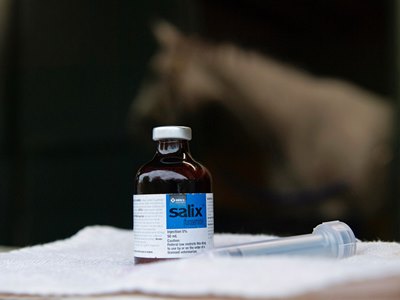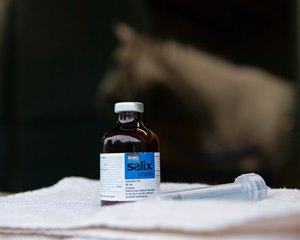Tracks, Industry Groups to Jointly Fund Lasix Study


A group of industry-leading organizations, regulators, and racetracks have agreed to jointly fund North America's largest study on the effects of furosemide and on the prevalence and severity of exercise-induced pulmonary hemorrhage in 2-year-old racehorses.
The study will aim to address the debate surrounding whether an injection of the diuretic furosemide, commonly referred to as Lasix, has beneficial, detrimental, or no effects on the welfare of examined racehorses. It has the financial backing of The Stronach Group, Breeders' Cup, Churchill Downs Inc., Keeneland, the Kentucky Horse Racing Commission, the Kentucky Thoroughbred Association, and the New York Racing Association.
Formally titled "Furosemide: Its Effects on the Prevalence and Severity of Exercise-Induced Pulmonary Hemorrhage and the Immune System's Normal Response to Exercise in Two-Year-Old Racehorses," the study began this month and is being led by Dr. Warwick Bayly and Dr. Macarena Sanz from the Department of Veterinary Clinical Services at Washington State University's College of Veterinary Medicine. This study represents the largest study ever to focus on evaluating the effects of furosemide on juvenile racehorses.
The use of furosemide has been a dominant issue confronting North American racing for more than a decade. The study offers an opportunity to address unanswered questions at the heart of furosemide use, namely:
1. Does the administration of furosemide four hours before racing and/or training reduce the severity of EIPH in 2-year-old racehorses?
2. Does the pre-race administration of furosemide four hours before racing affect a horse's performance?
The study will evaluate the endoscopic exams from at least 600 horses from three groups representing the major racing jurisdictions of California, Delaware, Florida, Kentucky, Louisiana, Maryland, Pennsylvania, New Jersey, and New York. Horses will be evaluated in three groups: 1) those who are given furosemide at least 48 hours before racing or not at all; 2) those who are given furosemide 24 hours before racing or not at all; 3) those who are administered furosemide four hours before racing. Veterinary practitioners from each of the jurisdictions will be asked to recruit trainers who are existing clients to voluntarily participate in the study.
"This study provides an opportunity to fill a critical knowledge gap on the use of furosemide," Bayly said. "As a first-of-its-kind study of this depth, it is our hope that once completed, we will be able to provide additional information that will enable the horse racing industry to address the regulation of furosemide in the United States from a scientifically informed perspective."
"The current patchwork of rules and regulations across the United States regarding the administration of furosemide does a disservice to the horses and the practitioners who care for them," said Dr. Dionne Benson, the chief veterinary officer for TSG. "This study is an opportunity for industry stakeholders to come together to invest in meaningful steps to address pressing questions so that we may develop a higher and more consistent standard of rules and regulations."
"The use of Lasix has long been a highly debated topic. This is our opportunity, as advocates for the safety and welfare of our racehorses, to collect and analyze vital real-life information that can be used to help answer some questions regarding the use of Lasix and its effect, but also guide common-sense regulation around Lasix use," said Dr. Will Farmer, the CDI equine medical director.
Preliminary results from the study are expected to be available next spring, assuming the quantity and quality of the samples satisfy the requirements for statistical relevance as set out by Bayly and Sanz.
"This study represents a unique collaboration of North American racing interests to further understand the true rate of EIPH in young racehorses through endoscopic examinations performed in post-race settings," said Dr. Stuart Brown, the equine safety director at Keeneland. "The potential to gain insight under the present landscape of furosemide use across various racing jurisdictions will help shape decisions that benefit the safety and welfare of the equine athlete in competition."
